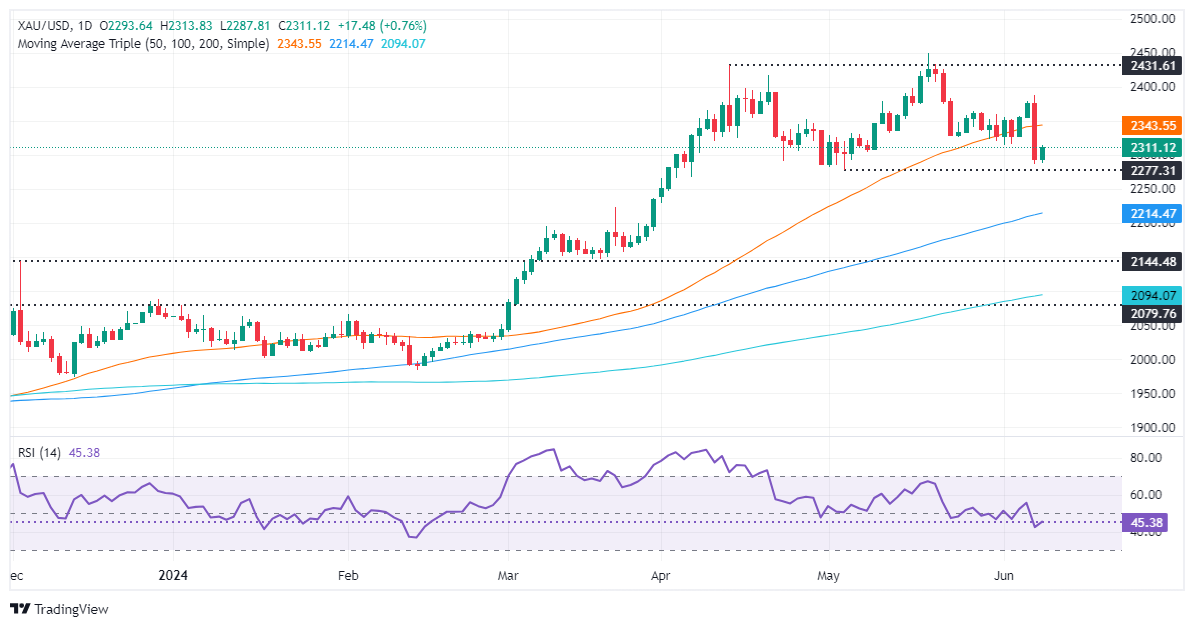Gold price shines and defy high US yields, firm US Dollar

- Gold trims some of last week’s losses, posts gains of over 0.50% despite USD strength.
- US Nonfarm Payrolls report shows resilient labor market with 272,000 jobs added.
- Upcoming US inflation data and Fed decisions are likely to impact Gold’s future trajectory.
Gold posted solid gains on Monday, rising more than 0.50% as US Treasury yields climbed. Although the yellow metal exchanged hands above last week’s low of $2,277, it is on the defensive amid broad US Dollar strength ahead of the release of crucial US economic data. The XAU/USD trades at $2,311 at the time of writing.
Last week’s US Nonfarm Payrolls for May showed that the labor market remains resilient even though previous reports showed that it was cooling. Nevertheless, 272,000 jobs were created, more than the estimated 185,000. In the same report, the Unemployment Rate rose, while Average Hourly Earnings increased slightly.
Given the backdrop, this week’s inflation report in the US would be crucial. Most analysts estimate inflation to remain at familiar levels, which could reaffirm the Federal Reserve’s (Fed) rhetoric of keeping interest rates “higher for longer.” On the other hand, a reacceleration could prompt Fed officials to adjust their rhetoric, which could pave the way for further losses to the non-yielding metal.
After the US inflation data is released, the Fed will announce its monetary policy decision and update the Summary of Economic Projections (SEP). Any hawkish tilts in the message or the dot plot could trigger volatility among market participants.
In the meantime, the US 10-year Treasury note yield edges up three-and-a-half basis points to 4.47%, a headwind for the yellow metal. Consequently, the DXY, an index of the US Dollar against six other currencies, increased 0.23% to 105.17.
Daily digest market movers: Gold price recovers after strong US jobs report
- News that the People’s Bank of China paused its 18-month bullion buying spree weighed on the precious metal. “Holdings of the precious metal by the PBOC held steady at 72.80 million troy ounces for May,” according to MarketWatch.
- Upcoming US CPI report for May is expected to show headline inflation at 3.4% YoY, while core CPI is foreseen dipping from 3.6% to 3.5% YoY.
- Last week, employment data in the United States spurred speculation that the Fed will keep rates higher for longer.
- Last week’s US data decreased the odds for a Fed rate cut in September, according to the CME FedWatch Tool, from above 50% to 46.7%.
- December’s 2024 fed funds futures contract hints that investors expect 28 basis points of rate cuts by the Fed throughout the year.
Technical analysis: Gold price climbs, hovers around $2,310
Gold price consolidates above $2,300, even though a Head-and-Shoulders chart pattern emerged. Momentum shifted bearishly as shown by the Relative Strength Index (RSI), which has pierced below the 50-midline, an indication that sellers are in charge.
Therefore, further Gold weakness and sellers could push the spot price below $2,300. Once cleared, the next stop would be the May 3 low of $2,277, followed by the March 21 high of $2,222. Further losses lie beneath with buyers’ next line of defense at around the $2,200 figure.
On the flip side, if Gold buyers lift prices above $2,350, look for a consolidation in the $2,350-$2,380 area.
Fed FAQs
Monetary policy in the US is shaped by the Federal Reserve (Fed). The Fed has two mandates: to achieve price stability and foster full employment. Its primary tool to achieve these goals is by adjusting interest rates. When prices are rising too quickly and inflation is above the Fed’s 2% target, it raises interest rates, increasing borrowing costs throughout the economy. This results in a stronger US Dollar (USD) as it makes the US a more attractive place for international investors to park their money. When inflation falls below 2% or the Unemployment Rate is too high, the Fed may lower interest rates to encourage borrowing, which weighs on the Greenback.
The Federal Reserve (Fed) holds eight policy meetings a year, where the Federal Open Market Committee (FOMC) assesses economic conditions and makes monetary policy decisions. The FOMC is attended by twelve Fed officials – the seven members of the Board of Governors, the president of the Federal Reserve Bank of New York, and four of the remaining eleven regional Reserve Bank presidents, who serve one-year terms on a rotating basis.
In extreme situations, the Federal Reserve may resort to a policy named Quantitative Easing (QE). QE is the process by which the Fed substantially increases the flow of credit in a stuck financial system. It is a non-standard policy measure used during crises or when inflation is extremely low. It was the Fed’s weapon of choice during the Great Financial Crisis in 2008. It involves the Fed printing more Dollars and using them to buy high grade bonds from financial institutions. QE usually weakens the US Dollar.
Quantitative tightening (QT) is the reverse process of QE, whereby the Federal Reserve stops buying bonds from financial institutions and does not reinvest the principal from the bonds it holds maturing, to purchase new bonds. It is usually positive for the value of the US Dollar.
